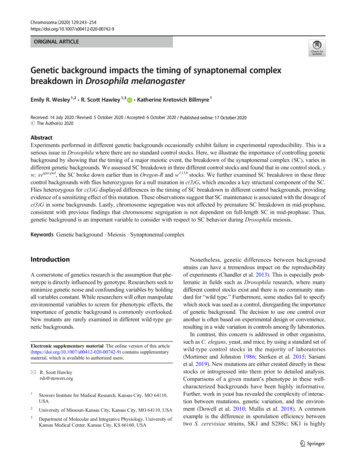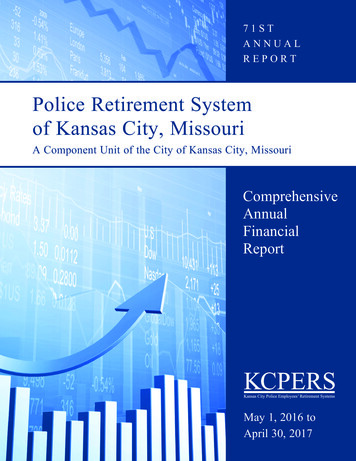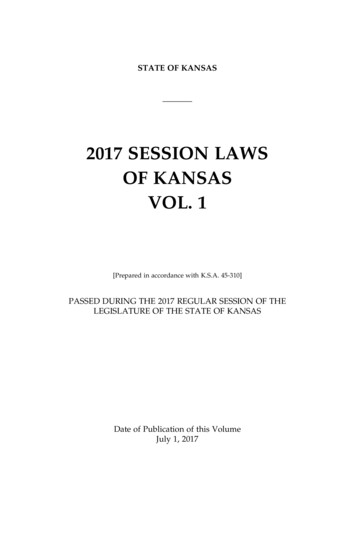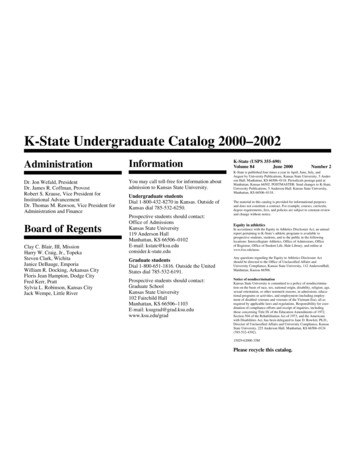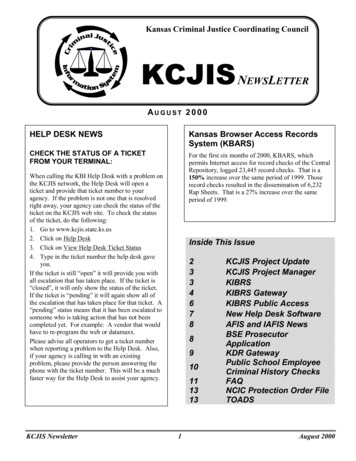
Transcription
Kansas Criminal Justice Coordinating CouncilKCJIS NEWSLETTERAUGUST 2000HELP DESK NEWSKansas Browser Access RecordsSystem (KBARS)CHECK THE STATUS OF A TICKETFROM YOUR TERMINAL:For the first six months of 2000, KBARS, whichpermits Internet access for record checks of the CentralRepository, logged 23,445 record checks. That is a150% increase over the same period of 1999. Thoserecord checks resulted in the dissemination of 6,232Rap Sheets. That is a 27% increase over the sameperiod of 1999.When calling the KBI Help Desk with a problem onthe KCJIS network, the Help Desk will open aticket and provide that ticket number to youragency. If the problem is not one that is resolvedright away, your agency can check the status of theticket on the KCJIS web site. To check the statusof the ticket, do the following:1. Go to www.kcjis.state.ks.us2. Click on Help Desk3. Click on View Help Desk Ticket Status4. Type in the ticket number the help desk gaveyou.If the ticket is still “open” it will provide you withall escalation that has taken place. If the ticket is“closed”, it will only show the status of the ticket.If the ticket is “pending” it will again show all ofthe escalation that has taken place for that ticket. A“pending” status means that it has been escalated tosomeone who is taking action that has not beencompleted yet. For example: A vendor that wouldhave to re-program the web or datamaxx.Please advise all operators to get a ticket numberwhen reporting a problem to the Help Desk. Also,if your agency is calling in with an existingproblem, please provide the person answering thephone with the ticket number. This will be a muchfaster way for the Help Desk to assist your agency.KCJIS NewsletterInside This Issue233467889101113131KCJIS Project UpdateKCJIS Project ManagerKIBRSKIBRS GatewayKIBRS Public AccessNew Help Desk SoftwareAFIS and IAFIS NewsBSE ProsecutorApplicationKDR GatewayPublic School EmployeeCriminal History ChecksFAQNCIC Protection Order FileTOADSAugust 2000
KCJIS Project UpdateA recent review of the KCJIS Project by twoconsulting firms concluded that significantpieces of the project had been delivered andimplemented. However, the consultants notedthat completion of the central repository wasbehind schedule. The reviews suggested anupdate of the project plan as well as thecompletion schedule. The updated plan andschedule should take into consideration vendorresources and scope of the project.In June the state released an RFP to acquire aconsultant to assist in the revision of the KCJISProject Plan, update the project budget, andprovide short-term management to coordinatestate and vendor resources on the project. Thecontract for services will be awarded bySeptember 1.What has the KCJIS Project accomplished?······Replaced the Automated FingerprintIdentification System (AFIS)Replaced the statewide telecommunicationsswitch with a high speed server that runs onTCP/IP protocol over the state’s wide areainformation network (KANWIN)Installed a secure web server as a low costalternative to the new message switchInstalled a network security system thatallows safe and efficient use of the Internetto conduct criminal justice businessInstalled web browser access to the state’scriminal history records, allowing criminaljustice agencies direct access to criminalhistories whenever neededA local law enforcement case managementapplication has been installed at 131agencies, allowing them to electronically····transmit offense data to the KBI via a securesocket connectionThe KIBRS 2000 application has beeninstalled at the KBI and is currentlysupporting all KIBRS data entry1999 and 2000 KIBRS data has beenmigrated to the new central repository forstorage and retrievalThe new KIBRS database is fullycompatible with the FBI NIBRS ProgramA new document imaging system installed atthe KBI has allowed the central repository toimage all disposition reports and crossreference them to arrest recordsWhat remains in the KCJIS Project?······The addition of “hot files” to the statewidecommunications system; includingmisdemeanor warrants, missing persons,registered offenders, and an officer safetyfeature known as BOLO (be on the lookout)Installation of the backup message switch atSalinaCompletion of the new adult and juvenilecriminal history database at the KBICompletion of the local case managementapplication for prosecutors, including theedit gateway and the secure socketconnection to the KBIInterface AFIS to the FBI’s IAFISKCJIS NewsletterInterface the criminal history database toAFIS, III, and the electronic dispositionreporting gateway· Interface KCJIS with databases at DOC, JJAand OJAQuestions, or comments about the KCJISProject? Contact KBI Assistant Director ChuckSexson at 785-291-3029, orsexson@kbi.state.ks.us.2August 2000
Legislature Approves A Full-time KCJIS Project ManagerRecognizing the need for a full-time project managerto coordinate the various KCJIS initiatives, the 2000Legislature approved funding for a KCJIS Manager.The Criminal Justice Coordinating Council hasinitiated a search for the new position. The followingad will appear in a number of area newspapers:“Criminal Justice Information System projectmanager for State of Kansas. Criminal justicebackground; strong project management, budgeting,information technology and communicationexperience/skills; bachelor’s degree required.Unclassified position oversees continueddevelopment of multi-agency state/localcriminal justice information system;communicates regularly with stateelected/cabinet officers, legislators, localcriminal justice agencies. Submit letter/resumeto Don Heiman, DISC Director, 900 SWJackson, Rm. 751S, Topeka, KS 66612-1275.EOE.”KIBRS Law Enforcement Case Management ApplicationVersion 1.6.0 of the KIBRS Law Enforcement CaseManagement Application (KIBRSLE) along with theKIBRS Gateway Application is scheduled to bedistributed to 131 Kansas law enforcement agencies.As of August 1, Business Software and Equipment(BSE) had installed the application in 22 agencies insoutheast and southwest Kansas. Another 31 agenciesare scheduled for installation in August.Agencies using KIBRSLE are required to submitKIBRS data through the KIBRS Gateway as indicatedin their Memorandum of Agreement with the KansasCriminal Justice Coordinating Council. Prior toinstallation of 1.6.0 and the Gateway, an agencyneeds to determine how they will communicatewith the host KIBRS Gateway Application at theKBI. The Gateway software is designed to onlywork on one computer; it cannot be loaded onseveral different computers within an agency.Further instruction on the requirements forconnecting to the KBI for KIBRS Gateway users isfound in the “KIBRS Gateway Connectivity”article on page 7.Kansas Incident Based Reporting SystemImplementation of the new KIBRS program hasaccelerated during the summer months. Distributionand installation of the KIBRS Law Enforcement CaseManagement application 1.6.0 along with the KIBRSGateway software began in July. Paradigm4implemented the production KIBRS database on July14, 2000. Views of the KIBRS database throughthe KCJIS Web server are currently beingprogrammed, and KBI staff has begun workingwith the Information Network of Kansas (INK) todevelop a new KIBRS statistical output for thepublic on the World Wide Web.KIBRSLE TrainingTraining is also being scheduled for KIBRSLE usersbased on their scheduled installation date. Users whoseapplications were installed in July or that arescheduled for installation in August have been notifiedof their scheduled dates for training. The training for1.6.0 and the KIBRS Gateway is being paid forthrough the Kansas Criminal Justice ImprovementProject. In order to contain costs, three training siteshave been selected; the BSE offices in Leawood, theKCJIS Computer Lab at the KHP Academy in Salina,and at the Garden City Community College ComputerLab. Training will be conducted by BSE staff withassistance from the KBI.Since seating is limited, agencies will only be allowedto send one person. As a result, an agency shouldKCJIS Newslettermake every effort to send a staff person who cantrain additional personnel in the agency, once theyhave completed the BSE training class. The firstfull day of training will be devoted to using theapplication. The second day will address theadministrative functions such as setup and using theKIBRS Gateway. Some agencies may find itappropriate to send different staff persons to eachsession.Classes are scheduled to start at 8:00 a.m. eachmorning, ending at 5:00 p.m. on the first day and atnoon on the second day. Instructors will beavailable on the afternoon of the second day toprovide additional instruction or to answerquestions. Agencies will be notified of their trainingschedule by the KBI.3August 2000
KCJIS Newsletter4August 2000
KIBRS Gateway Application·The KIBRS Gateway Application contains theNIBRS required edits and transfer program tothe KBI. While this application interfaces withthe KIBRSLE application it will also be used byagencies with their own case managementapplications.The KIBRS Gateway Interfaces ControlDocument (ICD) has been sent to thirty-fiveagencies, along with a Memorandum ofAgreement that must be signed by the agencyhead in order to receive a CD of the Gatewayapplication and instruction manual. Onceagencies receive the application they mayrelease it to their vendor for testing. (The ICDcontains the programming instructions.)However, since acceptance of the softwaremakes the agency responsible for its distributionit is recommended that the agency sign amemorandum of agreement with their vendorstating:· The vendor will only use the software forthe development and testing of electronictransfer of KIBRS data to the KBI for theirspecific agency;The vendor will not make copies of thesoftware or distribute the software to anyother agency, vendor or third party;· The software cannot be distributed in anyform to individuals or organizations for useoutside the state of Kansas;· Any copies of the software in possession ofthe vendor at the completion of successfultesting will be returned to the agency.The KBI is currently setting up a second KIBRSGateway that will allow non-KIBRSLE agenciesto submit test data prior to full implementation.Further instruction on using this site will bereleased to the agencies once they have notifiedthe KBI that they are ready to begin testing.Agencies only using the Gateway will also needto determine how they will communicate withthe host KIBRS Gateway Application at theKBI. The Gateway software is designed to onlywork on one computer; it can not be loaded onseveral different computers within an agency.Further instruction on the requirements forconnecting to the KBI for KIBRS Gateway userscan be found in the “KIBRS GatewayConnectivity” article on page 7.NIBRS TestingThe Federal Bureau of Investigation is currentlyreviewing Kansas NIBRS data submissions forreasonableness. This is the final step in beingcertified as a NIBRS-compliant state. Prior tothis step, Paradigm4 had been sending test datato the FBI for validation since February.When test data is submitted to the FBI it is runthrough their validation program and thenreturned to the submitting agency with a reportlisting the errors found in the submission.Paradigm4 and BSE then reviewed the reportsreceived on the Kansas submissions and makeany needed changes to the KIBRS Gateway editprogram before submitting a new test file.At the completion of this testing phase, theKansas error rate was 0.03%. The remainingerrors were for invalid ORI numbers andsubmitting arrests for more individuals in a casethan were listed as suspects.KCJIS NewsletterTesting for reasonableness consists ofcomparing the reported number of Part 1 crimesfor the first six months of 1999 and 2000 inorder to determine if there are any largefluctuations in the numbers. A large fluctuationcould indicate a programming error or reportingrule violation in the NIBRS submission. Next,the FBI reviews the data for reportinginconsistencies. For example, they called about areported incident where a rape victim had alsobeen listed as a suspect because this would notbe a normal occurrence.Based on recent conversations with the FBINIBRS staff, it is anticipated that Kansas will becertified and submitting live NIBRS data bySeptember 1, 2000. The first submissions willcontain both 1999 and 2000 data. Submissionsto the FBI will be made on a monthly basis.5August 2000
Invalid ORI NumbersSeveral Kansas law enforcement agencies arecurrently using invalid ORI numbers or retiredORI numbers. Many of the drug task forces havebeen assigned ORI numbers by the KansasHighway Patrol for Kansas use only. If the drugtask force in your area has been assigned one ofthese numbers, please contact Capt. Ken Justice,KHP (913) 782-8100. Any ORI numbers fordrug task forces that are considered invalid bythe FBI NIBRS program will be resubmittedunder the Sheriff’s Office ORI number until theKHP advises the KBI of the new ORI.Also, some agencies may be using an inactiveORI number. Occasionally, a small city willdecide to eliminate their one or two-man policedepartment and contract with the local sheriff forlaw enforcement support. When this happens theagency's number is retired. Later, if the citydecides to again support a local policedepartment, the officers will use the same ORInumber, not realizing that the ORI number hasbeen retired. If you believe your agency falls inthis category, please contact Capt. Ken Justice atthe KHP. He can advise if your ORI number hasbeen retired and if so how to get it reactivated.KIBRS Database Web Browser ViewsKansas law enforcement agencies will be able toaccess the KIBRS database at the KBI for crimeanalysis through a series of views. In order toaccess the views, users will be required to usethe KCJIS Web server via a web browser. Viewsare designed to show the logical relationship ofdata reported in an Incident or Arrest.In order to maintain a responsive query programthe views have been constructed to controlprocessing time. Except for the Property View,users will be required to limit queries to oneagency or all agencies within a county and by adate range that is no greater than 31 days.Use of the system will be continuouslymonitored in order to determine if limitations aretoo restrictive, not restrictive enough or if otherviews of the data would be beneficial. Examplesof possible queries will be provided with thedescription of each view.Data will be returned in tabular format in theweb browser. In order to perform analysis orlimit the data further than what is provided, theuser will need to copy the file to Excel, Accessor some other similar application.The availability of current data will be based ona law enforcement agency being able to supportthe functions of the KIBRS Gateway editprogram and the frequency of KIBRS datauploads from the agency. Reports submitted forKBI data entry may not be available for severalweeks. As a result, data may not be consistentor complete for any agency or county.Eight views will be available:KCJIS NewsletterV1 – OffenseMappingMO – this view containsoffense location, offense type, premise, andmethod of operation. This view can be used tocreate a data file for an agency’s mappingapplication. It can also be used to map specifictypes of offenses in communities surrounding ajurisdiction in order to determine crime patterns.A method of operation can also be used to filterinformation from this view.V2 – OffenseWeaponActivity – this viewcontains the offense type, the weapons used inan offense and the associated criminal activity.Data from this view can be used to determine thetypes of weapons used when committingoffenses. Files can also be created to define theuse and types of weapons involved in a reportedincident based on the activity type (i.e. DomesticViolence), if the incident was the result of aHate/Bias towards the victim, or if the incidentoccurred on a campus.V3 – Victim – this view contains information onthe victims of offenses, it includes the victim’sfull name, demographics, and associated offenseby statute and NIBRS code. This view can beused to create files by offense type in order toanalyze typical victims or search for similar typevictims of offenses in order to establish apattern. Users are able to search for victims byname, including businesses.V4 – Suspect - this view contains data on thesuspects/offenders reported in an incident. Thisview can be used to create data files listing thesuspect’s name, demographics, vehicle andaddress.6August 2000
V5 – Property – this global view containsinformation on all reported stolen and recoveredproperty submitted through the KIBRS program.This view can be used to identify recoveredproperty not entered into NCIC or to look forsimilar types of stolen property in order toidentify a series of thefts within a community orcounty. This is the only view not restricted bycounty, agency or a time span.V6 – Drugs – this view contains the drugoffense, type and amount of drugs seized, anddata on the suspect/offender including theirname, demographics and address. This view canbe used to determine if a suspect has beeninvolved in other drug offenses, to locate apossible address on a suspect using the suspect’sname, analysis the types and amounts of drugsbeing seized and to focus on specific types ofdrug offenses and seizures.V7 – Arrestee – this view contains data on bothjuveniles and adults arrested for a violation ofreportable criminal offenses. This view is notconsidered part of an arrestee’s criminal historyfile. This information is to be used forinvestigation only or to compile arrest statistics.An agency could also use this view to determineif all their required arrest reports have beensubmitted to the KBI.V8 – Clearance – this view provides a list ofcases cleared by arrest or exceptional means. Auser will be able to construct a monthlyclearance report for their agency using this view.When developing a report the user mustdetermine if the clearance report is being builtbased on the incident date of report, or based onthe date of arrest and exceptional clearance date.Use of all three parameters together would beinvalid. Use of incident date as opposed toarrest/exceptional clearance date will create adifferent response.KIBRS Public AccessKBI staff is currently working with theInformation Network of Kansas (INK) to designa new KIBRS statistical Website. A copy of theNIBRS file along with the incident activitycodes will be provided to INK on a monthlybasis. INK will then convert the file to adatabase that can be used to drill down statisticalcompilations.For example, a user may see an initial screenshowing the total number of Group A offensesreported by Kansas law enforcement agencies. Adialogue box would appear asking the user ifthey want more information on a particularoffense. If the user selects “rape” a seconddialogue box would appear listing the availabledrill-down selections which could be the totalnumber of rape offenses reported by a county orcity, or different compilations such as victim andsuspect demographics, weapons involved,relationship of the victim to offender, time ofday, etc. The database will be interactive withINK KIBRS file (not the KIBRS database at theKBI).The KBI and INK will also be developingmaterial that will be released to the news mediaprior to the Website being launched. Thematerial will discuss the difference between theUniform Crime Reporting Program (UCR) andthe National Incident Based Reporting SystemKCJIS Newsletter(NIBRS). The state reporting rules will also bementioned as well as the current status of thereporting agencies. Please note that the newsmedia information will be forwarded to all lawenforcement administrators before any release ismade to the news media or the public.If you have any questions about the KIBRSrelated material, please feel free to contact MaryAnn Howerton, KBI CDIC Manager, at (785)296-8277 or email at howerton@kbi.state.ks.us7August 2000
KIBRS Gateway ConnectivityIf your agency has signed up to use KIBRSLE,you must have network connectivity before BSEstaff arrives on site to install the software. BSEstaff will install the KIBRSLE software and,where needed, the SecuRemote software anddigital certificate assigned by the KBI.Agencies that access KCJIS through a firewallwill not need the SecuRemote and digitalsoftware installed on the KBIRS Gateway, as thefirewall will be programmed to do theencryption and authentication instead of theindividual personal computer.The KBI has received numerous questionsregarding how agencies may determine if itsnetwork connectivity is ready. Once you haveidentified which PC will be used for the BSEGateway, you can check the networkconnectivity by ascertaining the following:· Does this PC currently have access toASTRA? If so, you are accessing KCJISand have network connectivity.If you have a KCJIS router installed at youragency, adding another device to this network ispreferable to paying for another Internet ServiceProvider. In addition to saving your agency thatmonthly cost for the ISP, when there is aproblem that affects the BSE terminal, it may bea problem with your ISP’s network which willrequire each agency to contact their ISP forassistance.Each mandated agency was provided with asmall 6 or 8 port hub. For those agencies thatare not mandated, you may want to purchase aninexpensive hub. This hub may be connected tothe KCJIS router and additional terminalsconnected. (Note: Additional terminalsaccessing ASTRA will require approval fromBob Eckhardt, State Security Officer (SSO),KHP, 785-296-5963, prior to coming up on thenetwork.)There were approximately 20 mandated agenciesthat did not receive a hub when the networkconversion occurred. DISC staff is currentlyshipping hubs to those remaining agencies. Ifyou are just receiving this hub or if your agencypurchases one of its own, it is the agency’sresponsibility to connect the devices to the hub.· Does this PC currently have access toKBARS? If so, you are accessing KCJISand have network connectivity.If this PC uses Verisign instead of the KBIassigned digital certificate, you will need tochange and use the KBI’s system.· Does this PC currently have access to theInternet that works? If so, you havenetwork connectivity.If you have signed the Memorandum ofUnderstanding to use the KIBRSLE software,you will be receiving a questionnaire in the verynear future. The questionnaire is designed toanswer the above-noted questions for you and toassist KBI staff in preparing BSE for theinstallation at each site.NEW HELP DESK SOFTWARE AND “TIDBITS”:The KBI Help Desk is now operating on a newHelp Desk Software. We owe a special thanksto Stan Pfeifer, KBI for writing the software forus. This new software not only allows our userto see the status of our tickets from our internetpage, but also does analysis for us. From thereports that we have been given we can come tothe following conclusions:· In the first six weeks after we implementedthe new software, we opened 794 tickets.· Of those total tickets only 3.5% of thoseopened were escalated to an outsideresource.KCJIS NewsletterAlso in reviewing the busiest times of the weekit looks like Wednesday and Thursday are thebusiest times for the help desk.If you are trying to call our help desk the busiesttimes for calls are 0800 hrs and from 1400-1500in the afternoon. So, you might keep that inmind when calling with questions.Our goal on the help desk is to close out a ticketas quickly as possible. In order to help us dothat, please remember to keep track of yourticket number so that you can provide it to theperson answering the phone. Tonya Thomanwas instrumental in designing the software.Special thanks to Tonya Thoman and StanPfeifer.8August 2000
KCJIS Newsletter9August 2000
AFIS and IAFIS NewsThe Kansas central site AFIS is still notcompletely in operation. There are remainingissues of installation, mostly now concernedwith the pending interfaces with thecomputerized criminal history (CCH) databaseand with the IAFIS (the federal AFIS connectionwith the FBI) system at the federal level. Thesewill sort themselves out as we put CCH and ourother systems on line.Recent Achievements and Current Activities·····Sedgwick County Sheriff’s Office hasjoined Saline, Johnson and Lyon CountySheriff’s Offices in submitting livescanbookings. As of the newsletter’s publicationdate, Franklin County is on the verge ofconnectivity as well. As soon as theirlivescan vendor overcomes a network issue,Franklin should become the fifth countywith connectivity.The host site AFIS received 886 livescansubmissions during the month of June. Thisnumber will continue to rise as counties jointhe system.Sedgwick County also joins Saline andJohnson Counties with automatedconnections between their livescan devicesto their local records management system(RMS) databases. This accomplishmentpermits text entry to be imported from theRMS program into the text message portionof the fingerprint file.Latent submission to the FBI. Printrak isdeveloping their plan to connect our latentworkstations to the IAFIS network. While··this hasn’t been accomplished, Printrakacknowledges the functionality is to beincluded in the host site AFIS.In order to work with IAFIS and takeadvantage of the FBI’s projected 2-hourturnaround of criminal identifications, theCentral Repository is currently hiringadditional staff to support the 10-printIdentification Unit. Once the additionaltechnicians and clerical staff are brought onboard, the Central Repository will begin 24hour/7 day per week operations. At thatpoint, all livescan submissions will be fullyprocessed at the AFIS host site (the KBI) asthe records are received. Once IAFIS isconnected, livescan bookings will then besent to the FBI for national identificationwithin that 2 hour turnaround.Leawood Police Department is in theprocess of awarding a contract for thepurchase of a new livescan device.Leawood intends on obtaining a fullycompliant device and connecting to the hostsite AFIS.BSE Prosecutor ApplicationBusiness Software and Equipment, Inc (BSE)has released the Beta version of the Prosecutor’scase management application. This is thecompanion application to the recently releasedLaw Enforcement case management applicationand the Court case management application.The CJIS project learned from the rollout of theLaw Enforcement application that it is better tobe cautious with the initial release. Rather thanrush Version 1.0, BSE has continued to workwith the design team to catch and correct asmany of the “bugs” as possible before installingthe program at a prosecutor’s office. Thisapproach has resulted in a stable Beta versionthat is now installed for intensive testing in fourcounties (Riley, Allen, Chase and Pratt).The current schedule is for the four Beta sites totest the software and report their findings to BSEKCJIS Newsletteron a continuous basis. At the end of a 30-daycycle, BSE will reissue the program with allfixes incorporated from the Beta site feedback.Another 30-day cycle will begin. The Betatesting will probably continue for two or three ofthese cycles. When the CJIS director is satisfiedthat the application is ready for release, BSE willschedule installation at participatingprosecutors’ offices. Current estimates are forrelease of Version 1.0 by the end of this calendaryear.Statewide, about two dozen prosecutor’s officeshave indicated that they will use this softwarepackage. Any other prosecutor interested inobtaining this application should contact LeeTafanelli, BSE Program Manager, at (785) 2324433 or at ltafanelli@bsegov.com.10August 2000
KCJIS Newsletter11August 2000
Kansas Disposition Report (KDR) GatewayAs reported in an earliernewsletter, BusinessSoftware and Equipment,Inc (BSE) is designing aninterface between localprosecutors and the CentralRepository to process andvalidate electronicallytransmitted criminal historyKansas Disposition Reports(KDR). This interface isknown as the “KDRGateway” and it willfunction much as does the KIBRSGateway. The agencies that usethis gateway are those withdatabases that will package all thedata found on the Kansas AdultDisposition Report (KADR) andthe Kansas Juvenile DispositionReport (KJDR) and send the databy electronic file rather than byuse of the printed forms.BSE started this project last year,but for a number of reasons itstalled. Now they have amendedthe original plan and begunwork in earnest. The firststeps involve developingthe gateway’s architectureand defining the businessrules for the movement ofdata. In support of this, theKBI has developed NISTmessage maps that governthe conditions under whicha disposition report issubmitted to the CentralRepository.ConferenceBSE will host a conference of programmers and interested others to discuss the details of the KDRGateway project and to assist local prosecutors in building to the gateway. This meeting will bescheduled for one day during the last week of August, 2000. If you are interested in participating in thegateway or the conference, please contact either Wayne Dirks at wdirks@bsegov.com, or SAC Dave Simat dsim@kbi.state.ks.us.Public Housing Record Check (HUD Backgrounds) UpdateUnder provisions of the 1996Housing OpportunityProgram Extension Act (Pub.L. 104-120), Public HousingAgencies (PHA) are entitledto obtain national criminalhistory records of tenantsand tenant applicants. Toobtain a record, the PHAmust go through thefollowing steps:· Obtain an ORI from theFBI. This isaccomplished byapplication to the KansasControl TerminalOfficer, Captain KenJustice (KHP, 122 SW7th Street, Topeka, KS66603-3847). This ORIwill have the suffix “Q,”which identifies a PHA.· Coordinate with a locallaw enforcement agencyto conduct an InterstateKCJIS Newsletter·Identification Index (III)record check, by name,using NCIC Purpose Code“H”. The result of thischeck is simply a “hit/nohit” - the res
KIBRS Law Enforcement Case Management Application Version 1.6.0 of the KIBRS Law Enforcement Case Management Application (KIBRSLE) along with the KIBRS Gateway Application is scheduled to be distributed to 131 Kansas law enforcement agencies. As of August 1, Business Software and Equipment (BSE) had installed the application in 22 agencies in






